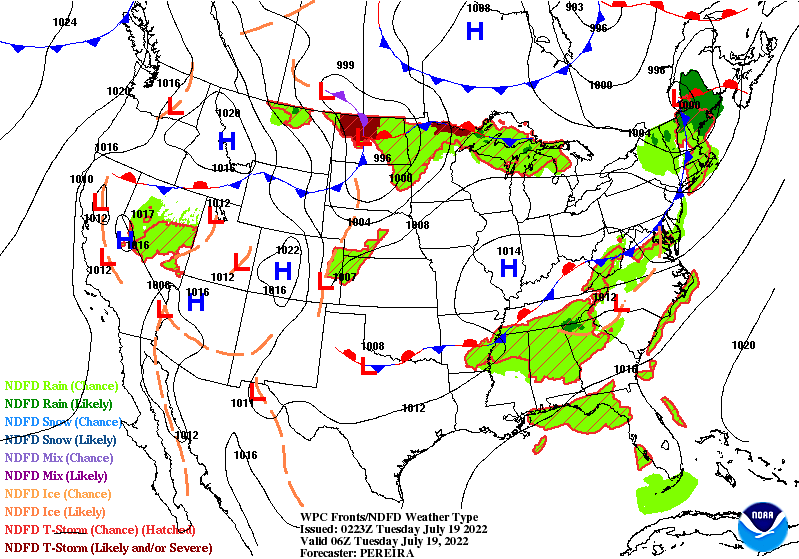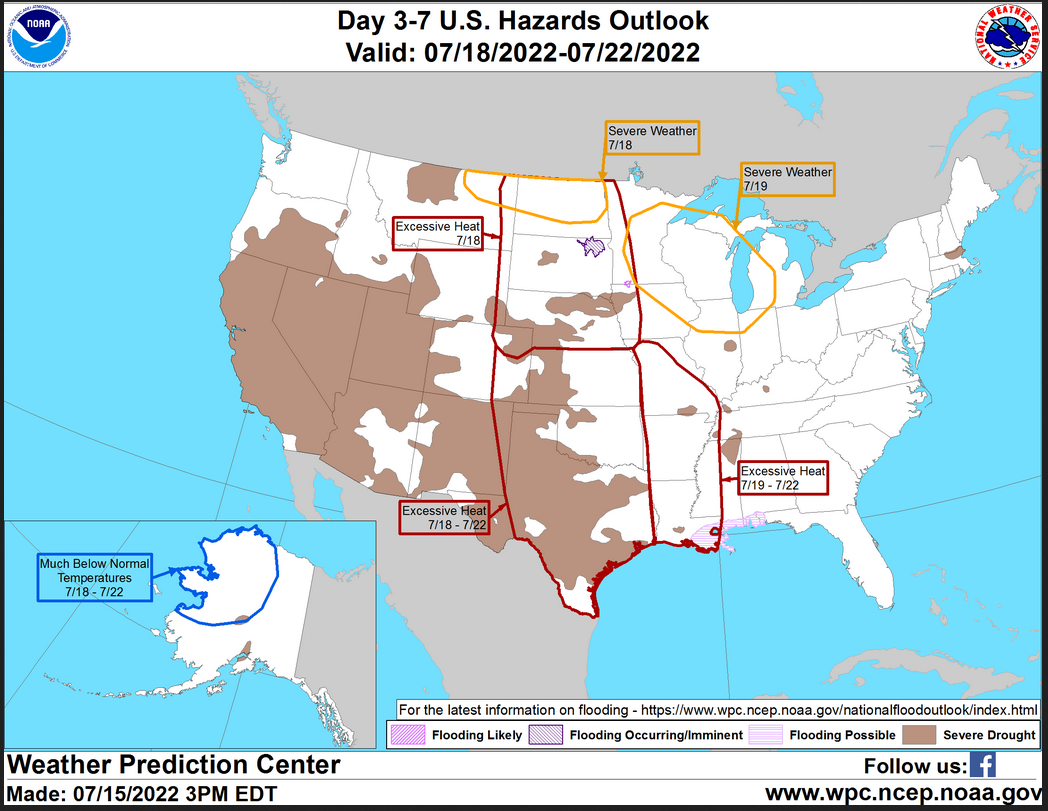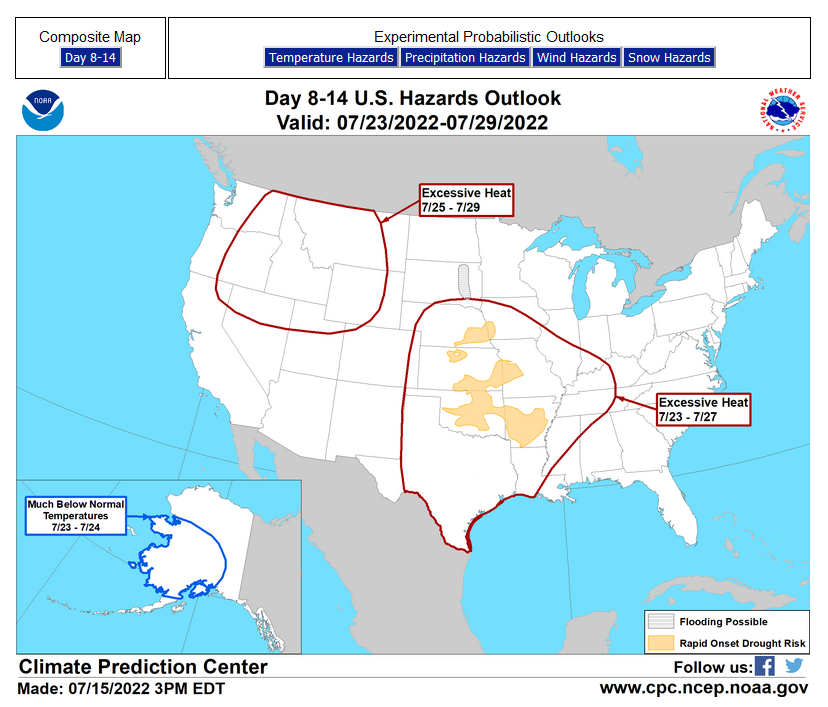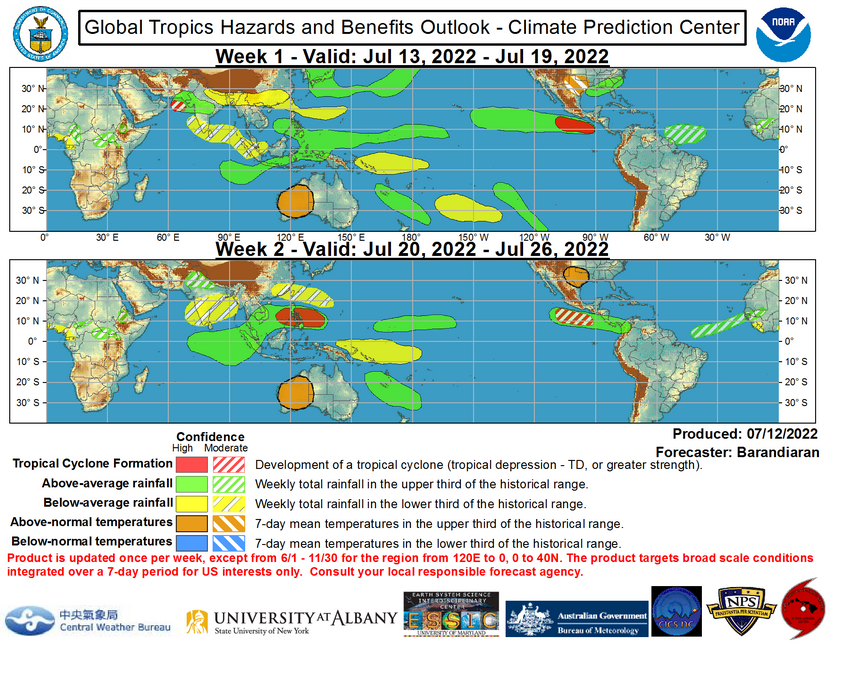Here is what we are paying attention to this evening and the next 48 hours from this evening’s NWS Forecast.
...Dangerous and record-breaking heat to impact much of the Great Plains... ...Scattered instances of flash flooding and severe thunderstorms possible throughout the Ohio Valley into tonight before the threat shifts into the Northeast on Monday... ...Severe weather chances enter the northern Plains on Monday and swing into the Upper Midwest/Great Lakes by Tuesday...
Continuation of the NWS Short Range Forecast (It is updated twice a day and these updates can be found here.
Record-breaking heat is expected to remain a major weather story over at least the next few days as a stagnant and strong upper level ridge stays anchored near the Four Corners region. In conjunction with surging southerly flow ahead of an approaching storm system over the northern Rockies, well above average temperatures are forecast to enter the northern/central Plains on Monday and consolidate into the southern Plains by Tuesday. Highs above 100 degrees will be widespread during this timeframe as several daily high temperature records are threatened from South Dakota to Texas. The only major relief in sight is expected to spread over the northern Plains by Tuesday behind a cold front. Otherwise, several days in a row with maximum temperatures into the triple digits will make conditions particularly dangerous for parts of Oklahoma and Texas. Excessive Heat Warnings and Heat Advisories have been issued for much of Oklahoma, central/northern Texas and into parts of the Lower Mississippi Valley. Heat Advisories are in effect across portions of the northern Plains. Hot weather is also forecast across much of the Great Basin and Southwest, with highs reaching into the upper 90s and 100s. Excessive Heat Warnings are in effect through Monday over the San Joaquin Valley of California. Residents and visitors across these regions are advised to follow proper heat safety and heed warnings issued by their local forecast office. In typical mid-summer fashion, showers and thunderstorms will also impact parts of the Nation with some storms capable of producing heavy rain, damaging wind gusts, hail, and isolated tornadoes. A strengthening low pressure system forecast to enter the Lower Great Lakes by Monday morning and its attached frontal boundaries will help focus numerous showers and thunderstorms over the Ohio Valley and central Appalachians through tonight. Areas of heavy rain may lead to scattered flash flooding throughout much of the Ohio Valley. Flood Watches have been issued for central/southern Ohio and surrounding nearby areas. A few storms may also turn severe into this evening from southwest Pennsylvania to northern Arkansas. By Monday, the severe weather threat shifts into the Northeast and northern Mid-Atlantic as an approaching cold front slides into a moist and unstable airmass. Damaging wind gusts and isolated tornadoes are possible from the Adirondacks of New York to northern Virginia. Intense rainfall rates may also accompany developing thunderstorms, with a Marginal Risk (level 1/4) of excessive rainfall stretching from the Northeast to the Tennessee Valley. Continued monsoonal moisture will create additional flash flooding chances over the Southwest, central Great Basin, and central/southern Rockies through at least midweek. Areas near recent burn scars, slot canyons, and terrain with overly saturated soils are most at risk to flooding impacts. Marginal Risks for Excessive Rainfall remain in effect through Tuesday across a broad region. Farther north, a potent upper level low entering the Pacific Northwest this afternoon will create a plethora of weather hazards as it traverses the northern tier states this week. First, gusty winds and low relative humidity will create elevated to critical fire weather conditions across the northern Great Basin through Monday. High winds are also likely into the northern High Plains, with gusts potentially reaching up to 65 mph. High Wind Warnings have been issued for Monday and Monday night over western/central Montana. Additionally, severe thunderstorms may develop ahead of the approaching cold front. A Slight Risk (level 2/5) of severe weather has been issued for Monday across northeast Montana and northern North Dakota. By Tuesday, the greater severe weather chances shift into the Upper Midwest/Great Lakes with damaging wind gusts expected to be the primary hazard.
Maps that relate the forecast to geography can be found by clicking Here for Day 1 and Here for Day 2.
Here is a 60-hour animated forecast map that shows how the short-term forecast is expected to play out.

Click here for the latest complete Day 3 -7 Hazards forecast which updates only on weekdays. Once a week probably Monday or Tuesday I will update the images. I provided the link for reads to get daily updates on weekdays. Use your own judgment to decide if you need to update these images.
Worldwide Tropical Forecast
(This graphic updates on Tuesdays) If it has not been updated, you can get the update by clicking here https://www.cpc.ncep.noaa.gov/products/precip/CWlink/ghazards/images/gth_small.png
Detailed Maps and Reports for the Western Atlantic and the Pacific Oceans
Below are three maps that summarize the situation for the Atlantic, Eastern and Central Pacific. Additional information can be accessed by clicking HERE
First the Atlantic
Click to view the forecast map and have access to additional information https://www.nhc.noaa.gov/gtwo.php?basin=atlc&fdays=5
Then Eastern Pacific
Click to view the forecast map and have access to additional information https://www.nhc.noaa.gov/gtwo.php?basin=epac&fdays=5
Then Central Pacific
Click to view the forecast map and have access to additional information https://www.nhc.noaa.gov/gtwo.php?basin=cpac&fdays=5
And the Western Pacific
Click to view the forecast map and have access to additional information https://www.metoc.navy.mil/jtwc/jtwc.html
Some Intermediate-Term Outlooks
Links to “Outlook” maps and discussions for three time periods. Days 6 – 10, Days 8 – 14, and Weeks 3 and 4. An outlook differs from a forecast based on how NOAA uses these terms in that an “outlook” presents information from deviation from normal and the likelihood of these deviations.
You have to click on the links because they do not update automatically and I do not want to have stale images in the article. But it is not difficult to click on a link and you get a large image plus a discussion. On Fridays in a separate article, we will show the images and provide a link in this article that article. But remember what you will see is the images as of Friday. But here you can get the current images simply by clicking on them. Then hit the return arrow at the upper left of your screen to return to the article. You will not find this information easily anywhere else.
Right now you can find these maps here (We show them every Friday there but you can click above and find them).
Month to Date Information
Temperature
Precipitation
Month to date Temperature can be found at https://hprcc.unl.edu/products/maps/acis/MonthTDeptUS.png
Month to date Precipitation can be found at https://hprcc.unl.edu/products/maps/acis/MonthPNormUS.png






